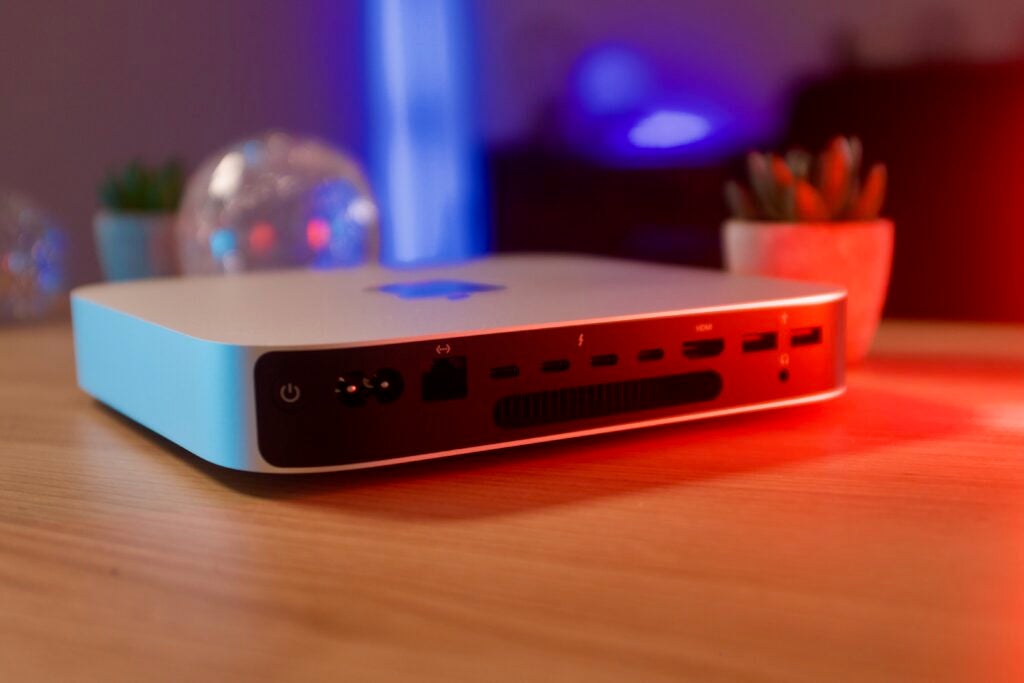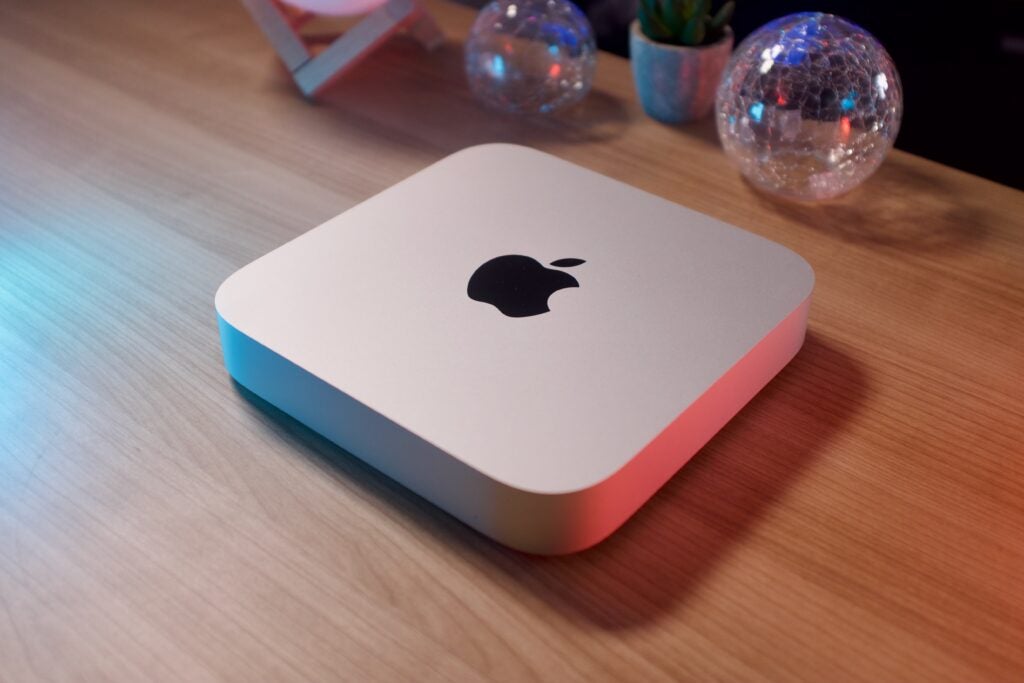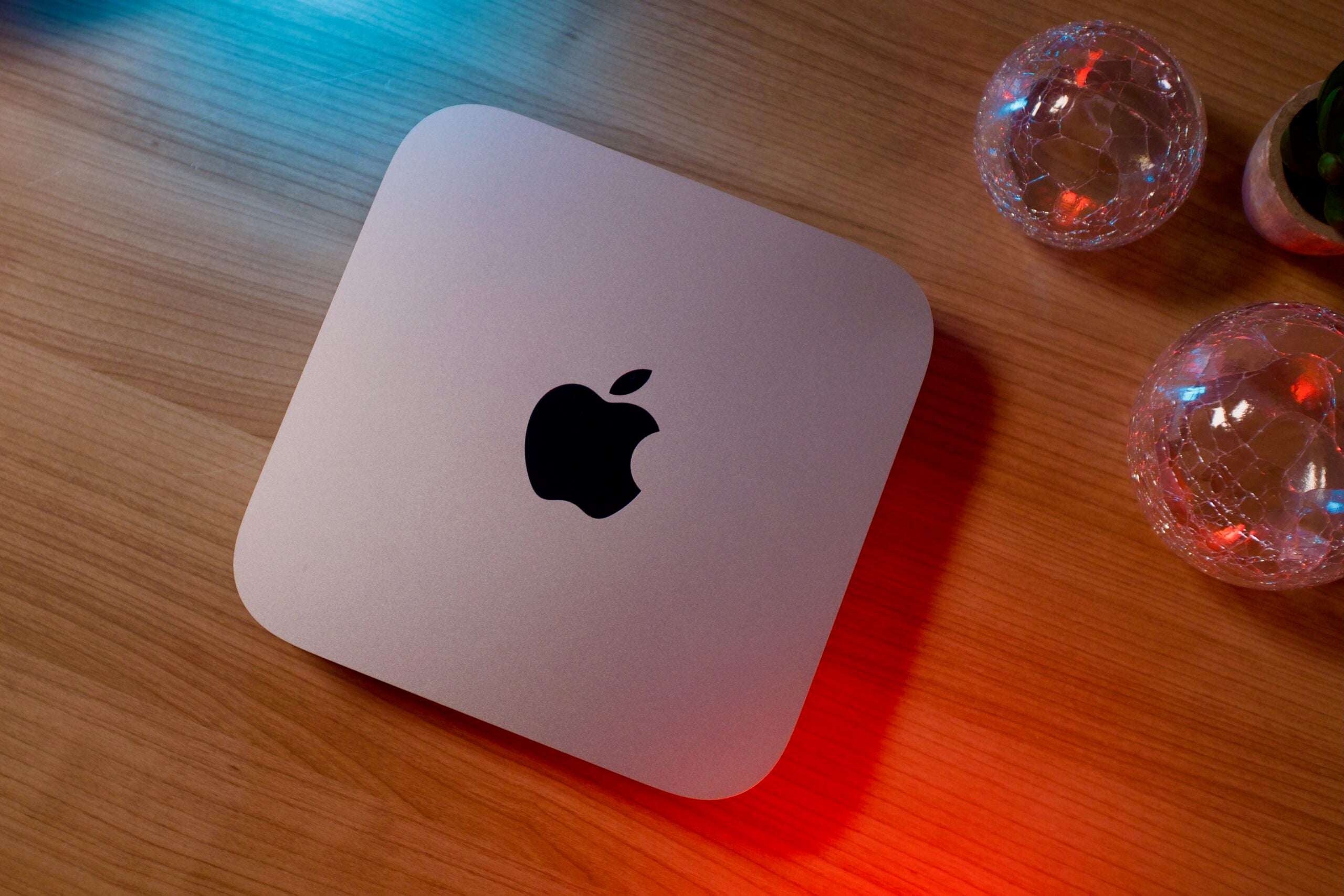Verdict
The Apple Mac Mini (2023) is a wonderful machine ideal for those who work primarily from one spot and need enough power to get tasks done without any speed issues.
Pros
- Easily fits into existing setups
- Powerful, and with plenty of options to make it more powerful
- Very quiet
Cons
- No SD card slot
- Higher-end M2 Pro models get close to Mac Studio’s price
Availability
- UKRRP: £649
- USARRP: $599
- EuropeRRP: €699
- CanadaRRP: CA$799
- AustraliaRRP: AU$999
Introduction
The Mac Mini (2023) is one of the easiest to recommend Apple computers I have ever reviewed.
Available with either the M2 – just like the MacBook Air M2 – or a more powerful M2 Pro chip, the Mac Mini (2023) is the most accessible way to jump into the M-series Mac ecosystem Apple has created.
Having two very distinct internal options also makes this a very versatile machine and in many ways a much better choice for most than the iMac 24-inch – especially for those who already have a monitor, keyboard and mouse lying around.
Design
- Simple, silver design
- All the ports on the back
- An SD card on the front would have been welcome
The Apple Mac Mini (2023) is a ridiculously simple machine to look at. This both goes in its favour, and against it.
The basic look and small dimensions allow the Mac Mini (2023) to easily fit into an existing setup. The computer stands less than 4cm tall and less than 20cm wide, making it roughly half the height of the Mac Studio which looked chunky in comparison.

I managed to slide the Apple Mac Mini (2023) under an existing monitor I tended to use with a connected MacBook, and I didn’t have to rejig too much to make it fit. I think the Mac Mini in general is best for those who already own a screen and peripherals (keyboard, mouse, trackpad) as that ensures the only outlay is for the machine itself.
The front and sides of the Mac Mini (2023) are completely clean, with all the I/O around the back. After using the Mac Studio, I found it slightly annoying having to reach behind the Mac Mini to plug anything in and the lack of an SD card reader (either on the front or the back) means many will have to add a dongle into the mix too. But then Apple will still want to sell the Mac Studio, so I can see why some of the features have been restricted to that.
The number of ports differs depending on the Mac Mini (2023) model chosen. The standard M2 model boasts HDMI (4K out up to 60Hz), 2x USB-A (up to 5Gb/s), 3.5mm headphone port, Gigabit Ethernet (configurable up to 10Gb Ethernet) and a duo of Thunderbolt 4-enabled USB-C ports. Move to the M2 Pro version and you get an extra two Thunderbolt 4 ports.
That’s a decent selection of ports, whichever way you look at it. I’m surprised USB-A remains, especially as it was ditched on the recent iMacs, and HDMI means it’s not just USB-C monitors that’ll work.

Don’t feel the Mac Mini (2023) is restricted to rigid desk use, though. This could be an awesome media machine plugged into the television or projector, while the 1.2kg weight means it can comfortably fit in a backpack for taking between home and an office.
For me, the Mac Mini (2023) is easier to recommend to more people than the quickly ageing M1-powered iMac 24-inch. Not only does it have a newer, slightly snappier chip (plus the option of a far faster one in the M2 Pro) but it has more ports and a more versatile design. With the iMac you’re stuck with a single 24-inch display – with the Mac Mini you can choose whichever screen size suits your space, be it smaller or bigger.
Performance
- Both M2 and M2 Pro options are available
- The base version is one of the best value Apple products
- Plenty of performance in a small shell
There are three versions of the Apple Mac Mini (2023) available directly from Apple and they vary quite a lot. In fact, it’s clear they are aimed at very different people.
The first two are powered by the M2 chipset (the same one you’ll find in the excellent MacBook Air) while the third swaps that for the M2 Pro – a faster chip that’s also found in the recent 2023 MacBook Pro 14-inch.
Apple could have easily labelled the M2 Pro option as a Mac Mini Pro and it probably would have made more sense.
The basic M2 model comes with up to a 2TB SSD, 24GB memory along with an 8-core CPU and 10-core GPU. Plump for the cheapest option and you’ll get a 256GB SSD and 8GB memory – enough power for basic use no doubt, and it should be fine for some light video and photo editing too. You’ll even get some decent gaming performance in titles like Football Manager 2023.
The M2 Pro model in its basic configuration comes with 512G storage, 16GB memory, a 10-core CPU and a 16-core GPU. This is the pick for those who want more grunt, and as a comparison, this is pretty much the same internal specs that power the base MacBook Pro 14-inch.
Spend a bit more (£300/$300) and you can upgrade to a 12-core CPU and a 19-core GPU, while the memory can be upped to 32GB and the SSD up to 8TB. Spec it up too much and you’ll get near the price of the base Mac Studio, which is still a better choice for true Pro users.
All models come with Wi-Fi 6E and Bluetooth 5.3, plus they can be configured with faster Ethernet for another extra fee.

For this review, I have been using the M2 Pro version with a 12-core CPU, 19-core GPU and 16GB memory. This is very much a high-end model, costing around £1700/$1700. While it’s nice having so much power, I don’t see this particular model being the most popular here – most spending this much would pay a bit more for the Mac Studio and the M1 Max chip (or wait for the likely M2 Max update). Instead, I can see the base model ($599/£649) being far more popular.
But, the M2 Pro configuration I have here is a seriously capable machine. It’s quiet too, with the fans rarely whipping up even when rendering video or exporting 4K footage. It benchmarks very closely to the MacBook Pro 14-inch, with seriously impressive graphics and CPU scores across the board.
The benefits of the upgraded GPU are most notable, with scores on average of over 5000 in the Basemark GPU. As a comparison, something like the Lenovo Slim 7i Pro with the RTX 3050 scored 1766. However, this is still well below the performance of a Mac Studio powered by the M1 Max.
You can see all the benchmark scores below; I have also included the MacBook Air M2 which will give an idea of how the cheaper M2-toting Mac Mini will run.
I was also impressed by the read and write speeds of the Apple Mac Mini (2023), which were noticeably faster than the MacBook Air. This should ensure speedy boot up times, as well as decent pace when installing or opening applications.
Elsewhere, the onboard speakers are adequate for podcasts and audio from YouTube videos though I would recommend connecting some external speakers – or maybe a HomePod Mini – for listening to music.
Latest deals
Should you buy it?
You don’t need a laptop:
If you work a lot from home, and already have a monitor, this is a smarter choice than plumping for a laptop. Either go for the M2 version and save lots of money or go for the M2 Pro and get more power than you’d ever find in a similarly-priced portable machine.
Portability is key:
However, if your use case is still very much working ‘on the go’ then a laptop remains a smarter choice and still gives you the ability to plug into a monitor if you need more screen.
Final Thoughts
The Apple Mac Mini (2023) is a wonderful machine, ideal for those who work primarily from one spot. If you go for the base model, you’re getting the power of the MacBook Air M2 for around half the price, while those who need more grunt – for creative tasks, like intensive video edits – can plump for the M2 Pro version instead.
This machine is easier to recommend than the iMac 24-inch with its M1 chip, not only because it’s more capable but because it’s more versatile – choose your screen size, choose your peripherals and make this fit in with your space. It’s best for those who already have a display, keyboard and mouse ready though, or else the initial outlay will quickly grow.
Having used the Mac Studio for so long, there are some design elements from that machine I would have loved to see trickle down here. The front-facing SD card slot, for example, is a tiny detail that makes a huge difference, while the front USB-C ports are welcome too for quickly plugging something without fiddling around the back. Sometimes the overly simple design here holds it back.
Still, the Mac Mini (2023) does enough to make it an easy choice for many people and it’s another example of how Apple’s M-series of chips is making worrying about performance in more affordable machines a thing of the past.
How we test
Every PC we review goes through a series of uniform checks designed to gauge key aspects including build quality, performance, and accessibility.
These include formal synthetic benchmarks and scripted tests, plus a series of real-world checks.
FAQs
There’s a single Silver colour available.
Nope, the only one included is a power cable.
Trusted Reviews test data
Jargon buster
GPU
The graphics processing unit is designed to render graphics, which is particularly important for gaming, creating 3D models and editing video.
SSD
Known as Solid State Drive, this is a faster form of a memory than a standard hard drive. Results in faster loading times and more ambitious games.

























